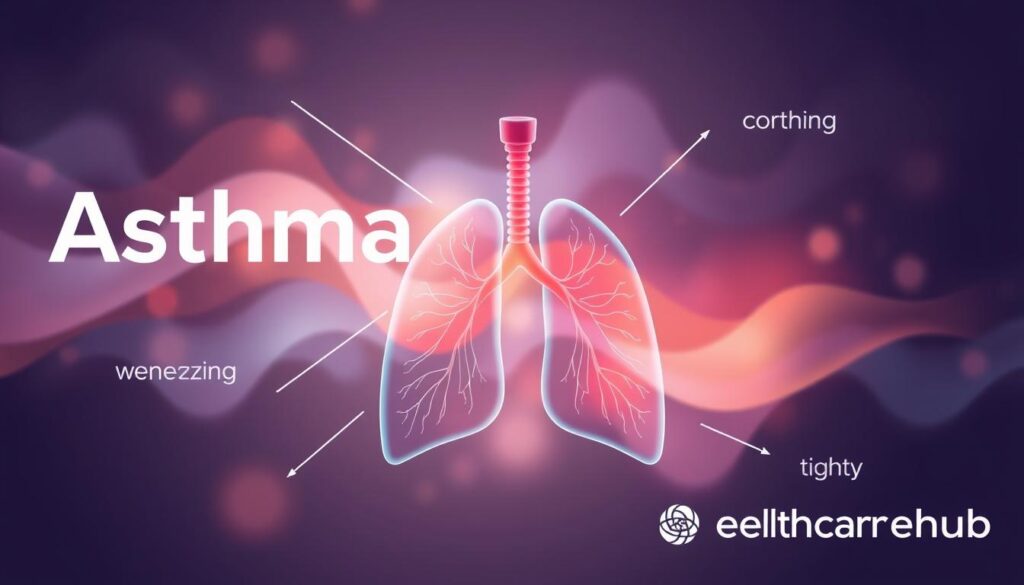Asthma is a chronic lung condition that affects over 25 million Americans, including 7 million children. It causes breathing difficulties due to narrowed airways. If not properly managed, it can be serious. Symptoms include wheezing, shortness of breath, coughing, and chest tightness.
While there is no cure for asthma, effective management strategies can help control symptoms. This improves quality of life. This article offers expert-backed techniques for managing asthma. It covers understanding the condition, creating personalized action plans, and identifying triggers.
Key Takeaways
- Asthma affects over 25 million Americans, including 7 million children.
- Asthma symptoms can include wheezing, shortness of breath, coughing, and chest tightness.
- Effective asthma management strategies can help control symptoms and improve quality of life.
- This article provides expert-backed techniques for managing asthma, from understanding the condition to creating personalized action plans and identifying triggers.
- Proper asthma management involves using medications as prescribed by a doctor and avoiding triggers.
Understanding Asthma: Causes and Risk Factors
Asthma is a complex condition caused by genetics and environment. Knowing the common risk factors and triggers is key to managing and preventing asthma.
Common Risk Factors and Genetic Predisposition
Having a parent with asthma increases your risk by three to six times. People with allergies, especially if their parents have them, are more likely to get asthma. Viral infections in childhood also raise the risk of chronic asthma.
Environmental Triggers and Their Impact
Some environmental factors can trigger asthma, making symptoms worse. Exposure to cigarette smoke, especially in pregnancy or secondhand, increases asthma risk. Living in polluted areas, like cities with high ozone levels, also raises the risk.
The Role of Inflammation in Airways
Asthma causes inflammation in the airways, leading to swelling and narrowing. This makes airways sensitive to substances, causing symptoms like shortness of breath and wheezing. Understanding this is key to managing and preventing asthma.
| Risk Factor | Increased Asthma Risk |
|---|---|
| Parental Asthma | 3-6 times higher |
| Allergies | Higher risk, especially if a parent has allergies |
| Childhood Viral Infections | Higher risk of chronic asthma |
| Cigarette Smoke Exposure | Higher risk, especially during pregnancy or from secondhand smoke |
| Air Pollution | Higher risk in urban areas with elevated ozone levels |
| Obesity | Higher risk, potentially due to low-grade inflammation |
Understanding asthma’s causes helps people manage their condition and lower attack risks. It’s about knowing the genetic, environmental, and physiological factors involved.
“Asthma affects people in different ways, from being a minor nuisance for some to a major interference with daily activities for others that can even lead to life-threatening asthma attacks.”
Recognizing Asthma Symptoms and Warning Signs
Asthma is a chronic respiratory condition that can significantly impact one’s quality of life. Understanding the common Asthma Symptoms and recognizing the warning signs of an Asthma Attack is crucial for effectively managing this condition.
The hallmark symptoms of asthma include wheezing, a whistling sound when breathing, shortness of breath, persistent coughing (often worse at night and in the early morning), and a tightening sensation in the chest. These symptoms arise from the inflammation and narrowing of the airways, which can be triggered by a variety of environmental factors.
In children, the presentation of asthma symptoms may differ slightly, with wheezing being more prevalent, particularly during the night. It’s important for parents and caregivers to be vigilant in monitoring their child’s breathing patterns and seeking medical attention if they notice any concerning changes.
Recognizing the early warning signs of an asthma attack is essential for prompt treatment and prevention of severe episodes. These signs may include increased mucus production, fatigue, or a worsening of the usual asthma symptoms. Using tools like peak flow meters can help individuals track their lung function and predict potential asthma attacks, allowing for proactive management.
| Asthma Symptom | Description |
|---|---|
| Wheezing | A whistling or high-pitched sound when breathing, often caused by the narrowing of the airways. |
| Shortness of Breath | Difficulty breathing, especially during physical activity or at rest. |
| Chest Tightness | A feeling of pressure or discomfort in the chest, making it hard to breathe. |
| Coughing | A persistent or frequent cough, often worse at night or in the early morning. |
Asthma symptoms can range from mild and manageable to severe and life-threatening. Recognizing the warning signs early and seeking appropriate medical care is crucial for maintaining control over this chronic condition and preventing serious asthma attacks.

“Prompt recognition and treatment of asthma symptoms can make a significant difference in the quality of life for individuals living with this condition.”
Essential Components of Asthma Management
Managing asthma well means tackling several key areas. Experts say the main parts are patient education, avoiding asthma triggers, watching for symptom changes, and using medicine. By focusing on these, people with asthma can control their condition better and live fuller lives.
Creating a Personalized Asthma Action Plan
The Asthma Action Plan is the base of asthma care. It’s made with a doctor’s help and includes daily treatments, how to avoid triggers, and what to do during attacks. It’s important to see doctors often to update the plan and keep asthma under control.
Working with Healthcare Providers
Having a good relationship with healthcare providers is key. Doctors and nurses help patients understand their asthma, adjust medicines, and prevent attacks. Regular visits let them check how well the plan is working and make changes as needed.
Monitoring and Tracking Symptoms
- Using peak flow meters to check lung function
- Keeping a symptom diary to spot patterns and triggers
- Telling doctors about any symptom changes or medicine use
Keeping an eye on asthma symptoms is vital. It helps catch problems early and ensures the treatment plan works. This way, doctors can make the right changes to keep asthma in check.
“Well-controlled asthma is indicated by the ability to participate in normal daily activities including sleep, work, school, play, and sports without limitations due to breathing.”
By focusing on the main parts of asthma care, people can manage their condition better. This reduces the chance of attacks and helps them live a better life.
Medication Options and Treatment Strategies
Asthma is a chronic respiratory condition that needs careful management. Medication is key in controlling symptoms and preventing attacks. Asthma medications are mainly divided into quick-relief and long-term controllers.
Quick-Relief Medications: These medicines, like short-acting bronchodilator inhalers, give quick relief by relaxing airway muscles. They are used for acute asthma symptoms or to prevent symptoms during exercise.
Long-Term Control Medications: These, such as inhaled corticosteroids, are taken daily to reduce inflammation and prevent attacks. Some patients may need combination medications that include both quick-relief and long-term control components.
Using the right inhaler technique is essential for delivering asthma medications effectively. Healthcare providers teach the correct use of inhalers and other devices, like spacers or nebulizers. This is especially important for young children who may need special methods.
In severe cases, treatments like bronchial thermoplasty might be considered. This heat therapy reduces airway constriction, offering an alternative for those not responding to usual treatments.
The Asthma Treatment plan should fit the individual’s needs. It considers the severity of their condition, symptom patterns, and how they react to different Asthma Medication options. Regular monitoring and adjusting the treatment, with healthcare provider guidance, is crucial for controlling asthma and improving life quality.
| Asthma Medication Class | Examples | Primary Function |
|---|---|---|
| Short-acting Beta-2 Agonists | Albuterol, Levalbuterol | Provide quick relief of asthma symptoms |
| Inhaled Corticosteroids | Fluticasone, Budesonide | Reduce airway inflammation and prevent asthma attacks |
| Leukotriene Modifiers | Montelukast, Zafirlukast | Reduce inflammation and constriction of airways |
| Combination Inhalers | Fluticasone-Salmeterol, Budesonide-Formoterol | Provide both quick-relief and long-term control |
| Biologic Medications | Omalizumab, Mepolizumab | Targeted therapy for severe, uncontrolled asthma |
“The key to successful asthma management is finding the right balance of medications and developing a personalized treatment plan with your healthcare provider.”
Identifying and Avoiding Asthma Triggers
Managing asthma well means knowing and avoiding your personal triggers. These can be things like dust, pollen, and even exercise. By staying away from these triggers, you can control your symptoms better and avoid attacks.
Indoor Allergens and Environmental Factors
Indoor allergens like dust mites, pet dander, and mold can be big problems. Using covers, washing bedding hot, and controlling humidity can help. Also, keeping your home clean and well-ventilated is key.
Seasonal Triggers and Weather Changes
For those with allergic asthma, pollen and weather changes can make symptoms worse. Watching pollen counts and staying indoors when it’s high can help. Cold air can also trigger asthma in some people.
Exercise-Induced Asthma Management
Exercise can be a big trigger for many. Warming up right and using medicine before working out can help. Choosing the right activities and adjusting your routine can also help a lot.
By knowing and avoiding your asthma triggers, you can manage your condition better. Talk to your doctor to make a plan that fits your needs.
| Asthma Trigger | Avoidance Strategies |
|---|---|
| Dust Mites | Use impermeable covers, wash bedding weekly in hot water, reduce humidity levels, use HEPA vacuum cleaners |
| Pet Dander | Remove the pet from the home, use air filters, vacuum frequently |
| Mold | Identify and remove existing mold, reduce humidity levels, use exhaust fans |
| Pollen | Monitor pollen counts, avoid outdoor activities during high-risk periods, keep windows closed |
| Cold Air | Wear a scarf or mask to warm and humidify the air, avoid prolonged exposure to cold air |
| Exercise | Use pre-exercise medication, warm up properly, choose appropriate activities |
“Removing asthma triggers in the home has been shown to decrease hospitalizations, emergency department visits, and rescue medication use in both children and adults.”
Lifestyle Modifications for Better Breathing
Asthma management is more than just medicine. Changing your lifestyle is key to better breathing. Regular exercise can make your lungs work better and reduce swelling in your airways. But, always talk to a doctor before starting a new exercise plan.
Keeping a healthy weight is also important for asthma management. Losing 5-10% of your body weight can really help control asthma. Stress can make asthma worse, so managing stress with deep breathing or meditation is helpful.
If you have allergic asthma, making your home less allergenic is a good idea. Eating foods that fight inflammation, like fruits and veggies, can also help. Stay away from things that can trigger asthma, like cigarette smoke and strong smells.
By making these lifestyle changes and using your medicine as directed, you can control your asthma better. Taking charge of your asthma management can greatly improve your life.
| Lifestyle Modification | Benefits for Asthma |
|---|---|
| Regular Exercise | Improves lung function, reduces airway inflammation, and promotes stress reduction |
| Healthy Weight Management | Reduces asthma severity and improves control |
| Stress Management Techniques | Helps control asthma symptoms by mitigating the impact of stress |
| Allergy-Proofing the Home | Minimizes exposure to common indoor allergens that can trigger asthma |
| Anti-Inflammatory Diet | Supports overall respiratory health and reduces inflammation |
By making these lifestyle changes, you can play a big role in managing your asthma prevention. This can lead to better breathing and a happier life.

“Lifestyle changes, combined with proper medication use, can significantly improve asthma control and overall well-being.”
Emergency Response and When to Seek Medical Help
Knowing how to act during an asthma emergency is key. The Centers for Disease Control and Prevention says about 1.8 million emergency visits are for asthma each year. Sadly, asthma causes around 4,000 deaths yearly.
Signs of a severe asthma attack include quick breathing trouble, no relief from quick-relief inhalers, hard to speak, and blue lips or fingernails. If you see these signs, get medical help right away.
Your asthma action plan should tell you when to go to the emergency room. Keep emergency numbers handy. Regular check-ups with your doctor can help avoid emergencies by keeping your asthma in check. The National Heart, Lung, and Blood Institute says about half of asthma patients don’t manage their condition well.
Teaching family and caregivers about emergency steps is vital for handling severe asthma attacks. Respiratory infections, like the common cold or flu, often trigger asthma attacks. If your asthma doesn’t get better with usual treatment, you need to see a doctor fast. Being ready and getting help when needed helps asthma patients live better, more active lives.















Becki Neuweg
I appreciate the detailed information shared here. Thank you for breaking down complex concepts so clearly. This blogpost answered a lot of questions I had. This post is really informative and provides great insights! The content in this blog is truly eye-opening. This blogpost answered a lot of questions I had. I can’t wait to implement some of these ideas. I’m bookmarking this for future reference.